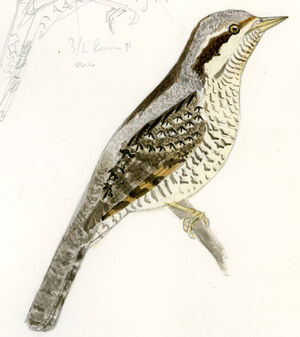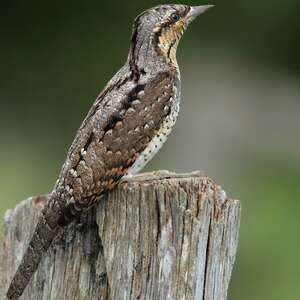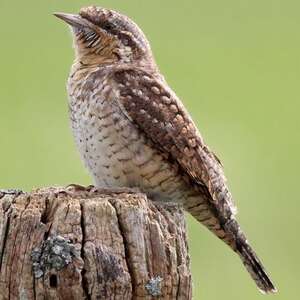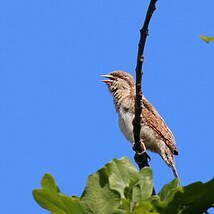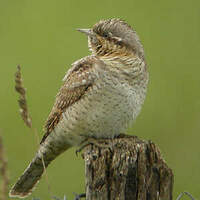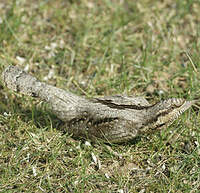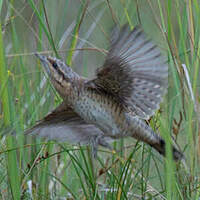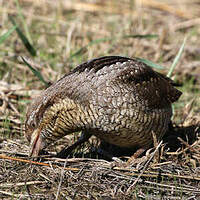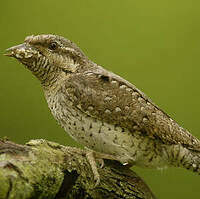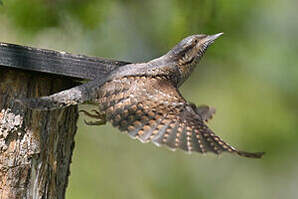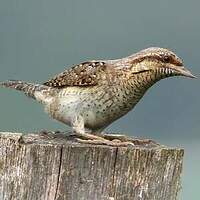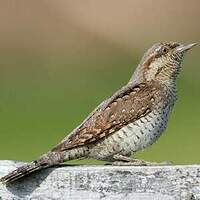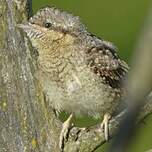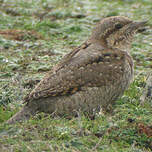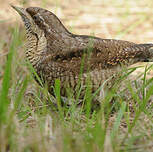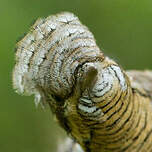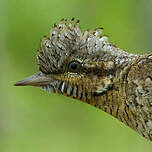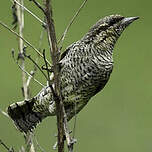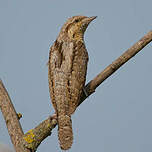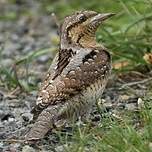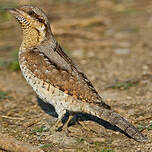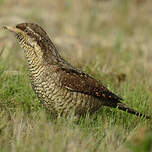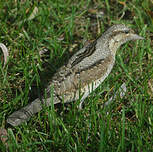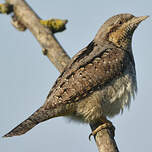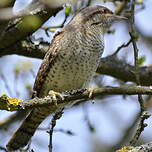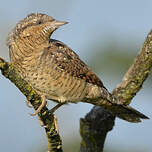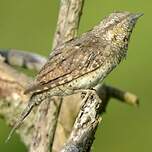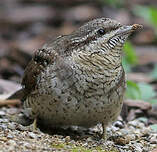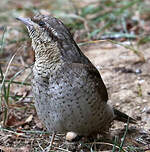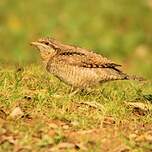Eurasian Wryneck
Jynx torquilla - Torcol fourmilier
Identification
The Eurasian Wryneck gets its generic name from the peculiar way it has of pointing its head upwards and then turning it from side to side alternately, giving the impression it is wringing its neck. Ringers are well aware of this behaviour since the bird adopts it when held in the hand.
Although belonging to the family of woodpeckers, its size, posture and behaviour resemble more that of a passerine, though its appearance is different. The pointed beak and the 4 clawed toes, 2 turned forwards and 2 backwards, to grasp branches well are typical of the family.
The upper part of its plumage, a mix of brown, grey, rust and black, helps it to blend in against tree bark, as it mostly dwells arboreally, or with the ground as it mostly looks for food on the ground. The whitish underside is locally washed with tawny, and barred with brown at the throat, on the flanks and under the tail.
Subspecific information 6 subspecies
- Jynx torquilla torquilla (w Europe to Bulgaria and the Caucasus area)
- Jynx torquilla sarudnyi (w Siberia)
- Jynx torquilla chinensis (e Siberia and ne and c China)
- Jynx torquilla himalayana (n Pakistan and nw Himalayas)
- Jynx torquilla tschusii (s Europe)
- Jynx torquilla mauretanica (nw Africa)
Foreign names
- Torcol fourmilier,
- Torcecuello euroasiático,
- torcicolo-eurasiático,
- Wendehals,
- nyaktekercs,
- Draaihals,
- Torcicollo,
- göktyta,
- Vendehals,
- krutohlav hnedý,
- krutihlav obecný,
- Vendehals,
- käenpiika,
- colltort comú,
- Gauktíta,
- krętogłów (zwyczajny),
- tītiņš,
- vijeglavka,
- Вертишейка,
- アリスイ,
- 蚁䴕,
- นกคอพัน,
- 地啄木〔蟻鴷〕,
Voice song and cries
As is usually the case in Picidae, the song consists of the repetition of a typical note of the species. In the Eurasian Wryneck the note is plaintive kuein kuein kuein.... Males and females sing, sometimes in duet. The male has a higher pitched, louder tone with a higher frequency of syllable emission than the female, who sings less loudly, with a lower tone and a slightly slower rhythm.
Habitat
For reproduction, the Eurasian Wryneck looks for clear woods in plains and mid-mountain, in Europe up to 1500 m altitude in mountain ranges such as the Alps, higher towards the east.
During its wintering in Africa, the tree factor is less important as cavities are not essential. The bird can be found in many open, wooded or not, often shrubby, facies with easy access to the ground for foraging.
It happens regularly during the nocturnal migratory movements that the bird fliesover very stripped landscapes or even deserts and is then forced to stop during the day in non-protective environments.
Behaviour character trait
Like all Picidae, the Eurasian Wryneck is adapted to the arboreal environment in which its bark-colored coat makes it go unnoticed when it is still. When alerted, it extends its beak upwards, enhancing its broken branch look. During the nuptial parade, the couple engages in jerky body movements, the head shaking from left to right and the tail spread.
Flight
Dietfeeding habits
The Eurasian Wryneck is essentially myrmecophagous, that is to say an eater of ants, for 90% of its diet, and this in all seasons. It feeds mainly on the ground. Its long sticky tongue of a picid gives it access to ants in the crevices of the ground, where its head would not pass.
It can also consume other small arthropods such as insects, millipedes, spiders, very occasionally molluscs, small amphibians at emergence, or even bird eggs, but this remains minority in the diet.
Reproduction nesting
As with all woodpeckers, the Eurasian Wryneck is an cavity-nesting species during reproduction but it is unable to bore into the wood to create its nest, its bill is too weak.
It only occupies existing cavities, which may be a natural cavity or an old woodpecker's hole. It also gladly uses nest boxes. It may expel already established occupants of the cavity, such as other cavity-nesting birds, taking over their nest as it cannot build its own. but it does not seem to have the upper hand with the Starling.The Eurasian Wryneck only breeds once during the spring. In France, arrival on breeding grounds starts in the second fortnight of March but mostly takes place in April. The average date of laying is mid-May. Eight to ten eggs are often laid, sometimes more. Incubation, by both adults, lasts 11-12 days. The young can fly at the age of around 3 weeks. The average productivity of the population is only 4-5 fledglings, reflecting a large loss, which justifies the importance of the size of laying.
Geographic range
The Eurasian Wryneck is a species found in Eurasia from the Atlantic coast of Europe to the Pacific coast of Sakhalin and Hokkaido, at average latitudes. Six subspecies shared this large territory. It is not found in the British Isles and is rare or absent in the north-west of France. On the African continent, it only reproduces in the north of Algeria and Tunisia. Its wintering area in the Palearctic is very marginal. The African wintering area is subtropical and equatorial, extending from Senegambia to Ethiopia. In Asia, the bird winters on the Indian continent, in south-east Asia and in the south of Japan.
Threats - protection
IUCN conservation status
concern
in the Wild
threatened
evaluated
In France, the Eurasian Wryneck, had long been a regular and quite common bird, but from the first atlas surveys of the second half of the 20th century, a decline was noted which consists of a retreat of its distribution area in the northwest of the country and a general decrease in numbers. No need to be a great scholar to imagine the causes. The landscape changes induced by a policy of severe reallocation with valorisation of surfaces could only have a negative impact. The situation on their wintering grounds must certainly not have been better and must have contributed to the decline. Current and future climate changes do not bode well for this specialized species either. Finally, the crossing of the desert for this trans-Saharan migrant must be a real test.
Sources of information
- IOC World Bird List (v14.1), Gill, F and D Donsker (Eds). 2024-04-18.
Other sources of interest
 Specification sheet created on
22/07/2023 by Jean François
Specification sheet created on
22/07/2023 by Jean FrançoisTranslation by AI Oiseaux.net
published: 28-12-2022 - Updated: 29-12-2022
© 1996-2024 Oiseaux.net
- Accipitriformes
- Aegotheliformes
- Anseriformes
- Apodiformes
- Apterygiformes
- Bucerotiformes
- Caprimulgiformes
- Cariamiformes
- Casuariiformes
- Charadriiformes
- Ciconiiformes
- Coliiformes
- Columbiformes
- Coraciiformes
- Cuculiformes
- Eurypygiformes
- Falconiformes
- Galliformes
- Gaviiformes
- Gruiformes
- Leptosomiformes
- Mesitornithiformes
- Musophagiformes
- Nyctibiiformes
- Opisthocomiformes
- Otidiformes
- Passeriformes
- Pelecaniformes
- Phaethontiformes
- Phoenicopteriformes
- Piciformes
- Podargiformes
- Podicipediformes
- Procellariiformes
- Psittaciformes
- Pterocliformes
- Rheiformes
- Sphenisciformes
- Steatornithiformes
- Strigiformes
- Struthioniformes
- Suliformes
- Tinamiformes
- Trogoniformes

